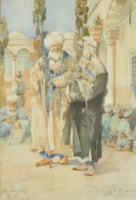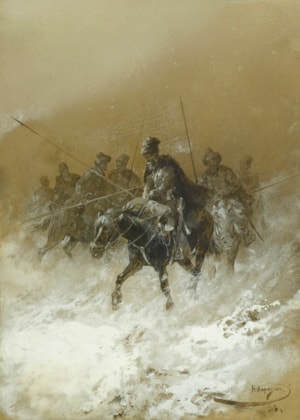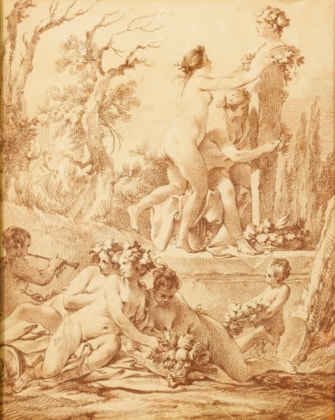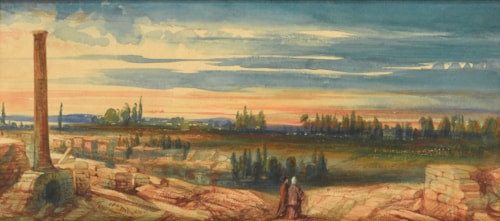Pavlikevitch
(Russian - 20th Century )
Figures in the Courtyard of the Bayezid II Mosque
inscribed and signed 'Istanbul/ J Pavlikevitch' (lower left) and inscribed in French (lower right)
watercolour on paper
43.2 x 29.2 cm (17 x 11½ in)
This lively watercolour shows two men in conversation, within the walls of the Bayezid II Mosque in Istanbul. The man on the left, holding a long cane, wears a turban and coat over a vibrant blue undergarment. In his hand he holds a string of Islamic prayer beads. Known as Misbaha, these beads, probably of Persian origin, are traditionally used by Muslims to keep track of counting in tasbih, or repetitive utterances of short sentences glorifying Allah. The man on the right wears a headscarf or yaşmak with blue, red and green stripes. The courtyard is bustling with activity, and provides an area for social exchange outside of religious commitments. On the right, three men facing the inner wall kneel in prayer, whilst behind the conversing pair an elderly man sits on the floor deep in thought.
Pavlikevitch uses a limited watercolour palette, choosing to focus on the blues found in the figures’ clothing and the terracotta in the surrounding architecture. The lightness of brushstroke and visible pencil lines suggest this study was created in situ by Pavlikevitch as he captures the moment of conversation between the two men.
The Bayezid II Mosque was commissioned by the Ottoman Sultan Bayezid II (c.1447-1512) and was the second imperial mosque to be built in Constantinople following the Ottoman invasion of 1453. The structure was built between 1501 and 1505 on the grounds of the Forum Theodosius (Forum Tauri), which was flanked by the Roman Capitol. Situated on a hilltop between the Mese (the main route of the historic peninsula) and the former site of the old Ottoman palace (Saray-i Atik), the complex consists of a mosque (cami), madrasa (medrese), soup-kitchen (imaret), Quranic school (mekteb), caravanserai (kervansaray), baths (hamam) and two tombs (türbe). The courtyard, as depicted in the present work, covers an area equal to that to the mosque itself, and the colonnade was constructed using materials appropriated from nearby Byzantine ruins.
This lively watercolour shows two men in conversation, within the walls of the Bayezid II Mosque in Istanbul. The man on the left, holding a long cane, wears a turban and coat over a vibrant blue undergarment. In his hand he holds a string of Islamic prayer beads. Known as Misbaha, these beads, probably of Persian origin, are traditionally used by Muslims to keep track of counting in tasbih, or repetitive utterances of short sentences glorifying Allah. The man on the right wears a headscarf or yaşmak with blue, red and green stripes. The courtyard is bustling with activity, and provides an area for social exchange outside of religious commitments. On the right, three men facing the inner wall kneel in prayer, whilst behind the conversing pair an elderly man sits on the floor deep in thought.
Pavlikevitch uses a limited watercolour palette, choosing to focus on the blues found in the figures’ clothing and the terracotta in the surrounding architecture. The lightness of brushstroke and visible pencil lines suggest this study was created in situ by Pavlikevitch as he captures the moment of conversation between the two men.
The Bayezid II Mosque was commissioned by the Ottoman Sultan Bayezid II (c.1447-1512) and was the second imperial mosque to be built in Constantinople following the Ottoman invasion of 1453. The structure was built between 1501 and 1505 on the grounds of the Forum Theodosius (Forum Tauri), which was flanked by the Roman Capitol. Situated on a hilltop between the Mese (the main route of the historic peninsula) and the former site of the old Ottoman palace (Saray-i Atik), the complex consists of a mosque (cami), madrasa (medrese), soup-kitchen (imaret), Quranic school (mekteb), caravanserai (kervansaray), baths (hamam) and two tombs (türbe). The courtyard, as depicted in the present work, covers an area equal to that to the mosque itself, and the colonnade was constructed using materials appropriated from nearby Byzantine ruins.




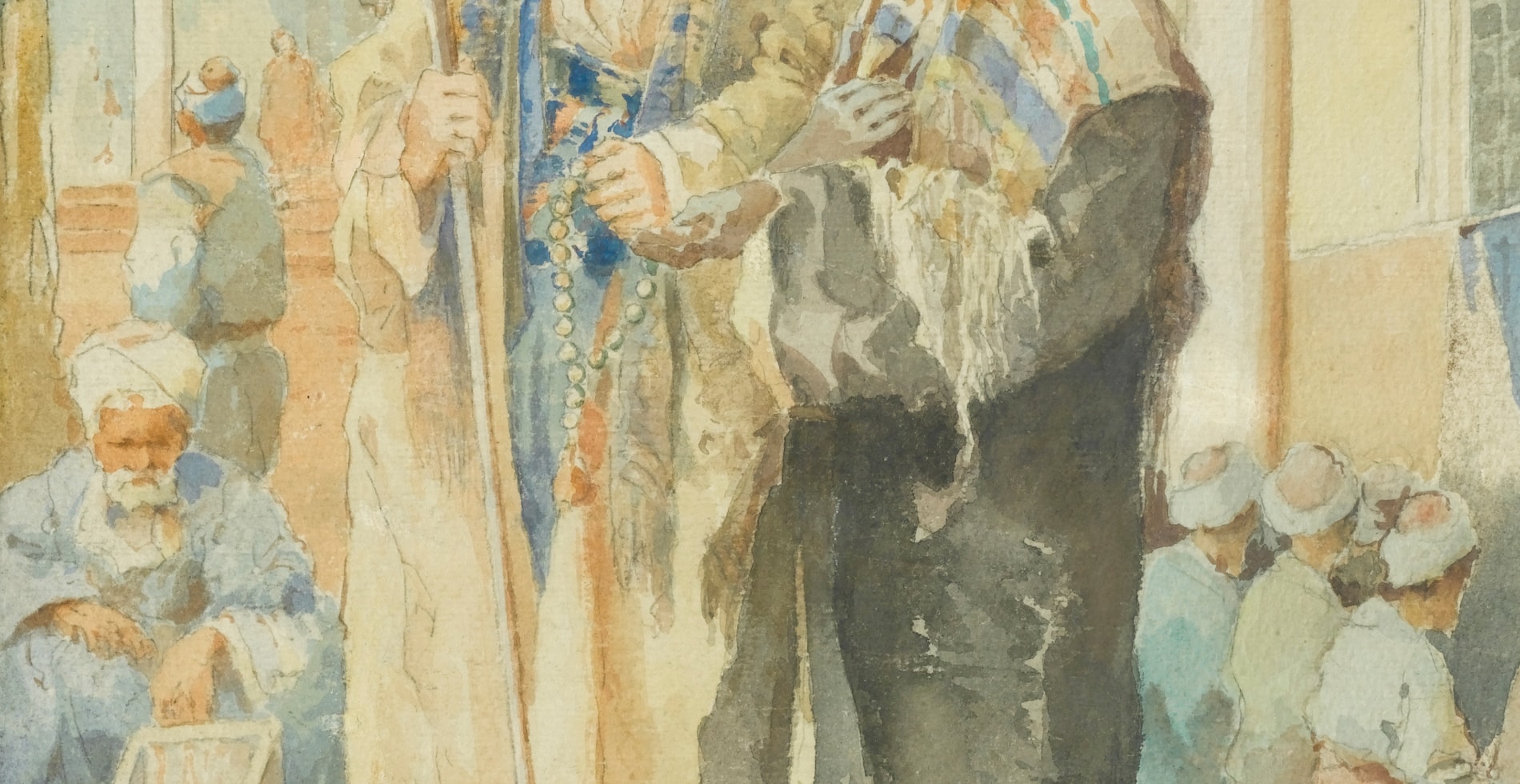
 contact
contact contact
contact +44 20 7313 8040
+44 20 7313 8040